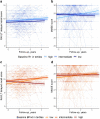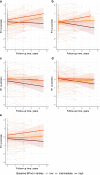Cerebral blood flow, amyloid burden, and cognition in cognitively normal individuals
- PMID: 36071221
- PMCID: PMC9816289
- DOI: 10.1007/s00259-022-05958-8
Cerebral blood flow, amyloid burden, and cognition in cognitively normal individuals
Abstract
Purpose: The role of cerebral blood flow (CBF) in the early stages of Alzheimer's disease is complex and largely unknown. We investigated cross-sectional and longitudinal associations between CBF, amyloid burden, and cognition, in cognitively normal individuals with subjective cognitive decline (SCD).
Methods: We included 187 cognitively normal individuals with SCD from the SCIENCe project (65 ± 8 years, 39% F, MMSE 29 ± 1). Each underwent a dynamic (0-70 min) [18F]florbetapir PET and T1-weighted MRI scan, enabling calculation of mean binding potential (BPND; specific amyloid binding) and R1 (measure of relative (r)CBF). Eighty-three individuals underwent a second [18F]florbetapir PET (2.6 ± 0.7 years). Participants annually underwent neuropsychological assessment (follow-up time 3.8 ± 3.1 years; number of observations n = 774).
Results: A low baseline R1 was associated with steeper decline on tests addressing memory, attention, and global cognition (range betas 0.01 to 0.27, p < 0.05). High BPND was associated with steeper decline on tests covering all domains (range betas - 0.004 to - 0.70, p < 0.05). When both predictors were simultaneously added to the model, associations remained essentially unchanged. Additionally, we found longitudinal associations between R1 and BPND. High baseline BPND predicted decline over time in R1 (all regions, range betasBP×time - 0.09 to - 0.14, p < 0.05). Vice versa, low baseline R1 predicted increase in BPND in frontal, temporal, and composite ROIs over time (range betasR1×time - 0.03 to - 0.08, p < 0.05).
Conclusion: Our results suggest that amyloid accumulation and decrease in rCBF are two parallel disease processes without a fixed order, both providing unique predictive information for cognitive decline and each process enhancing the other longitudinally.
Keywords: Alzheimer’s disease; Amyloid; Cerebral blood flow; PET; R 1.
© 2022. The Author(s).
Conflict of interest statement
Jarith Ebenau reports no disclosures relevant to the manuscript.
Denise Visser reports no disclosures relevant to the manuscript.
Sander Verfaillie reports no disclosures relevant to the manuscript.
Tessa Timmers reports no disclosures relevant to the manuscript.
Mardou van Leeuwenstijn reports no disclosures relevant to the manuscript.
Mara ten Kate reports no disclosures relevant to the manuscript.
Frederik Barkhof is a consultant for Biogen-Idec, Bayer-Schering, Merck-Serono, Roche, NovartisIXICO, and Combinostics; has received sponsoring from European Commission-Horizon 2020, National Institute for Health Research-University College London Hospitals Biomedical Research Centre, TEVA, Novartis, and Biogen; and serves on the editorial boards of
Philip Scheltens has acquired grant support (for the institution) from Biogen. In the past two years, he has received consultancy/speaker fees (paid to the institution) from Probiodrug Biogen, EIP Pharma, Merck AG.
Niels Prins is consultant to Boehringer Ingelheim, Aribio, and Amylyx. He is co-PI of a study with Fuji Film Toyama Chemical. He serves on the DSMB of Abbvie’s M15-566 trial. NP has received a speaker fee from Biogen. Payments were made to his company. He is CEO and co-owner of the Brain Research Centre, The Netherlands.
Ronald Boellaard reports no disclosures relevant to the manuscript.
Bert Windhorst reports no disclosures relevant to the manuscript.
Wiesje van der Flier Research programs have been funded by ZonMW, NWO, EU-FP7, EU-JPND, Alzheimer Nederland, CardioVascular Onderzoek Nederland, Health ~ Holland, Topsector Life Sciences & Health, stichting Dioraphte, Gieskes-Strijbis fonds, stichting Equilibrio, Pasman stichting, Biogen MA Inc, Boehringer Ingelheim, Life-MI, AVID, Roche BV, Fujifilm, Combinostics. WF is recipient of a grant for the Heart-Brain Connection crossroads (HBCx) consortium of the Dutch CardioVascular Alliance (DCVA). This work was supported by the Dutch Heart Foundation [#2018–28]. WF holds the Pasman chair. WF has performed contract research for Biogen MA Inc and Boehringer Ingelheim. WF has been an invited speaker at Boehringer Ingelheim, Biogen MA Inc, Danone, Eisai and WebMD Neurology (Medscape). WF is consultant to Oxford Health Policy Forum CIC, Roche, and Biogen MA Inc. WF was associate editor at
Bart van Berckel has received research support from EU-FP7, CTMM, ZonMw, NWO, and Alzheimer Nederland. BvB has performed contract research for Rodin, IONIS, AVID, Eli Lilly, UCB, DIAN-TUI, and Janssen. BvB was a speaker at a symposium organized by Springer Healthcare. BvB has a consultancy agreement with IXICO for the reading of PET scans. BvB is a trainer for GE. BvB only receives financial compensation from Amsterdam UMC.
Figures



References
MeSH terms
Substances
LinkOut - more resources
Full Text Sources
Medical

